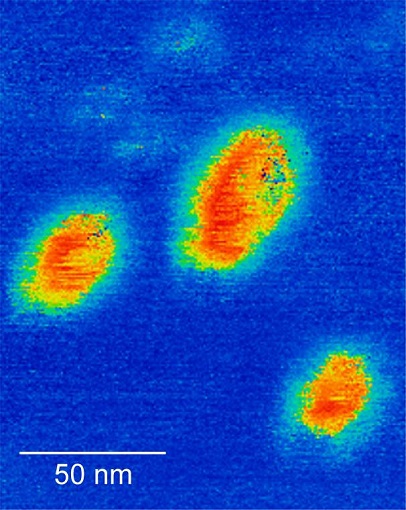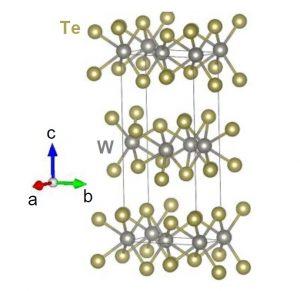THE LATEST
Australian researchers show first observation of native ferroelectric metal
tungsten ditelluride shows bistable and electrically switchable spontaneous polarization states; potential for new nano-electronics applications
In a paper released today in Science Advances, UNSW researchers describe the first observation of a native ferroelectric metal.
The study represents the first example of a native metal with bistable and electrically switchable spontaneous polarization states - the hallmark of ferroelectricity.
"We found the coexistence of native metallicity and ferroelectricity in bulk crystalline tungsten ditelluride (WTe2) at room temperature," explains study author Dr. Pankaj Sharma.  {module In-article}
{module In-article}
"We demonstrated that the ferroelectric state is switchable under an external electrical bias and explain the mechanism for 'metallic ferroelectricity' in WTe2 through a systematic study of the crystal structure, electronic transport measurements, and theoretical considerations."
"A van der Waals material that is both metallic and ferroelectric in its bulk crystalline form at room temperature has the potential for new nano-electronics applications," says author Dr. Feixiang Xiang.
FERROELECTRIC BACKGROUNDER
Ferroelectricity can be considered an analogy to ferromagnetism. A ferromagnetic material displays permanent magnetism, and in layperson's terms, is simply, a 'magnet' with north and south pole. Ferroelectric material likewise displays an analogous electrical property called a permanent electric polarisation, which originates from electric dipoles consisting of equal, but oppositely charged ends or poles. In ferroelectric materials, these electric dipoles exist at the unit cell level and give rise to a non-vanishing permanent electric dipole moment.
This spontaneous electric dipole moment can be repeatedly transitioned between two or more equivalent states or directions upon application of an external electric field - a property utilised in numerous ferroelectric technologies, for example nano-electronic computer memory, RFID cards, medical ultrasound transducers, infrared cameras, submarine sonar, vibration and pressure sensors, and precision actuators.
Conventionally, ferroelectricity has been observed in materials that are insulating or semiconducting rather than metallic, because of conduction electrons in metals screen-out the static internal fields arising from the dipole moment. 
THE STUDY
A room-temperature ferroelectric semimetal was published in Science Advances in July 2019.
Bulk single-crystalline tungsten ditelluride (WTe2), which belongs to a class of materials known as transition metal dichalcogenides (TMDCs), was probed by spectroscopic electrical transport measurements, conductive-atomic force microscopy (c-AFM) to confirm its metallic behavior, and by piezo-response force microscopy (PFM) to map the polarisation, detecting lattice deformation due to an applied electric field.
Ferroelectric domains - ie, the regions with the oppositely oriented direction of polarization - were directly visualized in freshly-cleaved WTe2 single crystals.
Spectroscopic-PFM measurements with a top electrode in a capacitor geometry were used to demonstrate switching of the ferroelectric polarization.
The study was supported by funding from the Australian Research Council through the ARC Centre of Excellence in Future Low-Energy Electronics Technologies (FLEET), and the work was performed in part using facilities of the NSW Nodes of the Australian National Fabrication Facility, with the assistance of the Australian Government Research Training Program Scholarship scheme.
First-principles density functional theory (DFT) calculations (University of Nebraska) confirmed the experimental findings of the electronic and structural origins of the ferroelectric instability of WTe2, supported by the National Science Foundation.
FERROELECTRIC STUDIES AT FLEET
Ferroelectric materials are keenly studied at FLEET (the ARC Centre of Excellence in Future Low-Energy Electronics Technologies) for their potential use in low-energy electronics, 'beyond CMOS' technology.
The switchable electric dipole moment of ferroelectric materials could, for example, be used as a gate for the underlying 2D electron system in an artificial topological insulator.
In comparison with conventional semiconductors, the very close (sub-nanometre) proximity of a ferroelectric's electron dipole moment to the electron gas in the atomic crystal ensures more effective switching, overcoming limitations of conventional semiconductors where the conducting channel is buried tens of nanometres below the surface.
Topological materials are investigated within FLEET's Research theme 1, which seeks to establish ultra-low resistance electronic paths with which to create a new generation of ultra-low energy electronics.
FLEET is an ARC-funded research center bringing together over a hundred Australian and international experts to develop a new generation of ultra-low energy electronics, motivated by the need to reduce the energy consumed by supercomputing.
